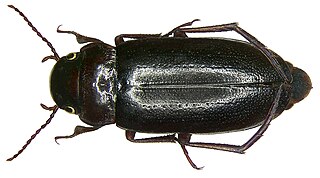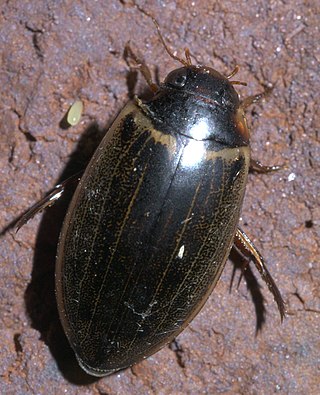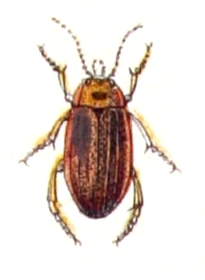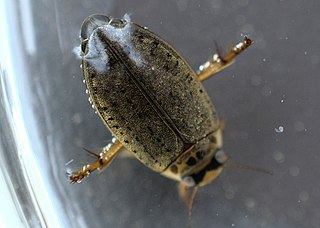Carabdytes alutaceus is an endangered species of beetle in the family Dytiscidae. It is endemic to New Caledonia, in the southwest Pacific Ocean.

Rhantus is a genus of beetle in family Dytiscidae. There are about 100 species distributed worldwide. They often live in pools and marshy habitat types. Several species have colonized oceanic islands and become endemics.
Rhantus novacaledoniae is a now extinct species of beetle in the family Dytiscidae. It was endemic to New Caledonia.
Rhantus papuanus was a species of beetle in family Dytiscidae. It was endemic to Papua New Guinea.

Carabdytes is a genus of predaceous diving beetles in the family Dytiscidae. Carabdytes upin was formerly the sole species of this genus, but nine species in the genus Rhantus were transferred to Carabdytes as a result of research published by Balke et al. in 2017.

Meridiorhantus calidus is a species of predaceous diving beetle in the family Dytiscidae. It is found in North America and the Neotropics. This species was formerly a member of the genus Rhantus.
Rhantus dani is a species of predaceous diving beetle in the genus Rhantus that was described by Balke in 2001.
Carabdytes plantaris is a naturally uncommon species of diving beetle in the family Dytiscidae. It is endemic to New Zealand. For over a century, it was known from just a single specimen collected in 1880 "near Dunedin", and doubts were cast on whether it was actually a New Zealand species at all. In 1986, it was rediscovered when several were collected from a roadside pond near Lake Ellesmere. Carabdytes plantaris is now classed as "naturally uncommon" by the Department of Conservation.

Nartus grapii is a species of beetle in family Dytiscidae, found in the Palearctic. This species was formerly a member of the genus Rhantus.

Rhantus frontalis is a species of predaceous diving beetle in the family Dytiscidae. It is found in Europe and Northern Asia and North America.
Nartus sinuatus Black with dark rufous legs; posterior margin of pronotum arched just before hind angles(3) is a species of predaceous diving beetle in the family Dytiscidae, found in North America. This species was formerly a member of the genus Rhantus.
Rhantus sericans is a species of predaceous diving beetle in the family Dytiscidae. It is found in North America.

Rhantus suturellus is a species of predaceous diving beetle in the family Dytiscidae. It is found in North America and the Palearctic.
Rhantus wallisi is a species of predaceous diving beetle in the family Dytiscidae. It is found in North America.

Rhantus gutticollis is a species of predaceous diving beetle in the family Dytiscidae. It is found in North America and the Neotropics.
Rhantus atricolor is a species of predaceous diving beetle in the family Dytiscidae. It is found in North America and the Neotropics.

Meridiorhantus is a genus of predaceous diving beetles in the family Dytiscidae. There are about five described species in Meridiorhantus, found in the Neotropics and North America. These species were formerly members of the genus Rhantus, but were moved to Meridiorhantus when it was created by Balke et al. in 2017.
Caperhantus is a genus of predaceous diving beetles in the family Dytiscidae. There is one described species in Caperhantus, C. cicurius. This species was formerly a member of the genus Rhantus.

Nartus is a genus of predaceous diving beetles in the family Dytiscidae. There are at least two described species in Nartus. These species were formerly members of the genus Rhantus, but were moved to Nartus when it was reinstated by Balke et al. in 2017.
Rhantus taprobanicus is a species of predaceous diving beetle found in India, Nepal, Pakistan and Sri Lanka.






